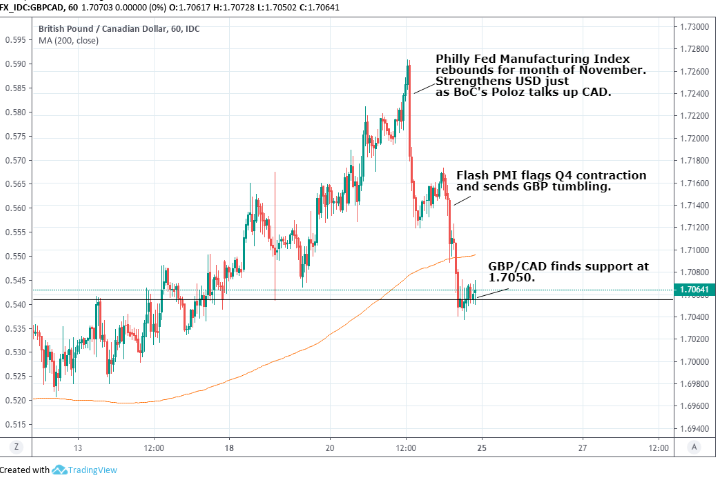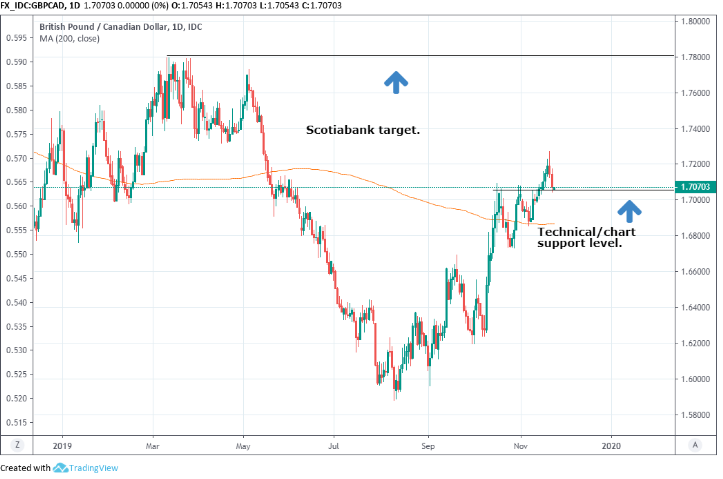Pound-Canadian Dollar Week Ahead Forecast: Breaking Higher after Finding Support on the Charts
- Written by: James Skinner
-

Image © Adobe Stock
- GBP closes out volatile week with modest gain over CAD.
- GBP poised to breakout higher on charts, says Scotiabank.
- Still on course for March 2019 high, support now at 1.7050.
- Sept GDP a key driver of CAD, BoC expectations this week.
- AS GBP eyes Conservative Party poll lead, manifesto launches.
The Pound-to-Canadian-Dollar exchange rate was volatile last week but has now found support on the charts and is being tipped by technical analysts to continue recovering ground that was previously lost during the summer months.
Pound Sterling popped higher in the opening session of last week, aided by an improving poll lead for Prime Minister Boris Johnson ahead of the December general election, although the exchange rate was further buoyed on Tuesday when deputy governor of the Bank of Canada (BoC) Carolyn Wilkins suggested that an interest rate cut could be just around the corner.
Canada's Dollar was left reeling by Wilkins' remarks and it wasn't until Governor Stephen Poloz contradicted the notion that a cut could be near in a subsequent address on Thursday that the Loonie began to retake previously lost ground from Sterling, but even then the Pound-to-Canadian-Dollar rate still closed the week 0.05% higher. And technical strategists at Scotiabank say it could make further gains in the week ahead.
"GBPCAD is breaking higher. The cross has been in consolidation mode for some weeks but closed above the recent highs around 1.7080 last night and is maintaining those gains on the day so far," says Juan Manuel Herrera, a strategist at Scotiabank. "We expected a bullish resolution to the recent (bull wedge) consolidation, which implied a resumption of gains above 1.7080/010 and that a push through the upper 1.70 area will lift the cross."

Above: Pound-to-Canadian-Dollar rate shown at hourly intervals.
Sterling was forced into a retreat against the U.S. Dollar on Thursday around the same time that BoC Governor Poloz was lifting the Canadian Dollar out of the trough carved out for it in the wake of Wilkins' speech. That's why the Pound-to-Canadian-Dollar rates, which always closely matches the sum of GBP/USD over CAD/USD, fell so sharply earlier in the week.
Scotiabank's Herrera says the Pound now enjoys a bullish alignment of trend signals on the intraday, daily and weekly 'directional-movement-indicators' and that this will initially lift the exchange rate to 1.73-1.74, before eventually taking it up to 1.78. That latter level has not been seen since March 2019, when the first of three delays to the UK's exit from the EU forced the Bank of England (BoE) to put on hold its plans to lift interest rates.
Herrera tipped 1.78 as a prospect earlier in November, a level that implied 5% upside at the time but which suggested on Monday, a modestly lesser increase of around4.4%. Initially, the Pound had been tipped to find support around 1.66 upon any bouts of fresh weakness but Herrera has since raised this level to 1.7050. Sterling is still down 2% against the Loonie for 2019 even though it rose 6.13% in the three months to November, but hitting Scotiabank's target would more-than eliminate the rest of that loss.
"The outlook for the CAD over the coming week (and perhaps a bit beyond) is very mixed, on the basis of our charts below. On the one hand, relative data surprises continue to shift in the favour of the USD while the seasonal under-performance in the CAD may still have some room to run," says Sean Osborne, chief FX strategist at Scotiabank," referring to the USC/CAD rate.

Above: Pound-to-Canadian-Dollar rate shown at daily intervals.
AA
The Canadian Dollar: What to Watch
The Canadian Dollar struggled last week after mixed messages from the Bank of Canada saw it cede ground to all but two of its major counterparts, although the looming release of September GDP data on Friday means policy expectations will again be an important influence on the currency this week.
There was no consensus available for Friday's GDP number, due out at 1330, although the BoC and some local economists are looking for growth to have slowed into the end of summer. GDP data is the headline economic release for the week, although wholesale sales data due out on Monday at 13:30 will be scrutinised by traders for clues on Friday's likely number.
"We’ve penciled in a slim 0.1% gain for September GDP, a weak handoff that starts the ball rolling towards the tamer 1.0% pace we expect for Q4 GDP," says Royce Mendes, an economist at CIBC Capital Markets.
Mendes and the CIBC team see the annualised pace of Canadian economic growth falling from 3.7% to 1.3% in the third-quarter as an earlier rebound in exports and the oil sector unwinds, while business investment slows in response to the U.S.-China trade war.
"Our forecast is for a 1.5% annualized increase in Q3 GDP, just a touch stronger than the BoC’s 1.3% projection," says Josh Nye, an economist at RBC Capital Markets. "We don’t think next week’s GDP report will be enough to change the BoC’s calculus ahead of its December 4th rate decision. But we still see the potential for a rate cut early next year."
BoC Governor Stephen Poloz reportedly told an audience at the Ontario Securities Commission Thursday that Canadian interest rates are "about right" for the current climate, barely a month after the bank omitted a similar and oft-repeated claim from the October policy statement. Canada's Dollar shot higher following the remarks, after having been crushed earlier in the week when Deputy Governor Carolyn Wilkins appeared to suggest a so-far elusive rate cut could be around the corner.
Wilkins said "you want to put the winter tires on before the snow falls. It not only protects you, but also everyone else using the road," leading markets to believe she'd rather cut rates before the global slowdown arrives on Canadian shores, instead of waiting until after.
"The BoC has opened the door to a rate cut, and will continue to weigh the costs and benefits of such insurance," says RBC's Nye. "It’s the household sector that will be key in upcoming monetary policy decisions. Signs that trade tensions and slowing global growth are having an effect beyond business investment and exports could make a dose of insurance worth the cost."
This was after the BoC said last month it's looking for signs an ongoing downturn in the manufacturing sector and a fall in business investment is having an adverse impact on households. Friday's data will provide some clarity about the answer to that question. Resilient households are the only thing standing between the Canadian cash rate of 1.75% and its next level down of 1.5%.
Poloz and the BoC have bucked the trend among peers this year, leaving rates unchanged at 1.75% even as the Federal Reserve and others cut in order to fend off a disinflationary global growth slowdown, which has helped make the Canadian Dollar the best performing major currency of 2019. However, that latter status could quickly disappear if markets begin to suspect the BoC might cut its cash rate sooner rather than later.
AA
Pound Sterling: What to Watch
Sterling was firmly in retreat heading into the weekend although with election manifestos having landed in the public domain and opinion polls now suggesting the Conservative Party lead is narrowing, the British currency might find itself on the defensive early in the new week.
Polls published in The Sunday Times and Sunday Express both had the Tory lead retreating by a couple of points this weekend with results collected after the televised leaders' debates but before the release of manifestos from the main parties. Meanwhile, a poll-of-polls featured in The Telegraph had the Conservatives on course for a 64 seat parliamentary majority, although other polls have suggested a lesser majority than that.
"Next week’s calendar will lack market-moving data releases, which will leave GBP being solely driven by the expectations around the elections (that are now only 20 days away)," says Chris Turner, head of FX strategy at ING. "For now, with expectations firmly around a Conservative win, sterling is likely to remain rangebound."
The Tories have enjoyed a strong lead over the opposition Labour Party since the December 12 ballot was announced but bitter memories of Theresa May's lead heading into the 2017 election, which proved to be erroneous, are containing enthusiasm for Sterling.
A Conservative majority would likely mean the agreement struck by Boris Johnson in October becomes law, taking the UK out of the EU but locking it into 'transition period' during which the future relationship is negotiated. Crucially for markets, the agreement would negate the threat of a 'no deal' Brexit, while electoral victory would spare the economy and Pound from years more of indecision and delay, if not worse, under an anti-Brexit opposition government.
There are no major economic numbers due for release in the week ahead, although the an IHS Markit PMI survey pointed last week toward another contraction for the economy in the final quarter, which weighed heavily on the Pound during the Friday session.
AA
Time to move your money? Get 3-5% more currency than your bank would offer by using the services of a foreign exchange specialist. A specialist payments provider can deliver you an exchange rate closer to the real market rate than your bank would, thereby saving you substantial quantities of currency. Find out more here.
* Advertisement









